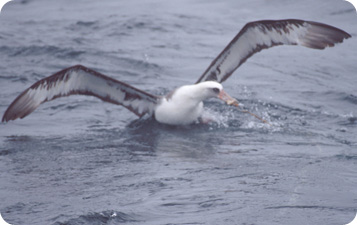 A Laysan albatross grabs onto the baited hook of a fishing boat's longline. Credit: National Oceanic & Atmospheric Administration
A Laysan albatross grabs onto the baited hook of a fishing boat's longline. Credit: National Oceanic & Atmospheric AdministrationSeabirds, such as petrels and albatrosses, often face peril from longline fishing, which mainly targets tuna and swordfish. These fishing boats pay out very long lines with baited hooks which sink to their fishing depth to lure prized fish. But before the lines sink very far, seabirds dive after the bait and get snared by the hook and dragged under.
How do fishermen deter seabirds from attacking the bait on their longlines? One way is to set out lines at night, when most seabirds are not feeding. Another is to attach brightly colored streamers to the lines to frighten the birds away.
A third technique is to set the baited lines out of reach. Typically seabirds spot and dive for the lines at the surface before they sink, so some fisherman deploy their lines underwater, where birds can’t see them. Using a funnel or chute, the boats send out lines 3 to 13 feet below the surface.
But many seabirds are talented divers. White-chinned petrels have been observed diving down to 40 feet to go after food. Keeping fishing lines completely out of the birds’ reach would mean deploying them deeper — and in rough seas, it can be difficult to keep lines at these depths.
Though no technique is perfect, these protection measures can reduce the number of seabirds hooked by longlines. And these efforts benefit fishermen, too — after all, a hook that has snared a seabird won’t catch a fish.


